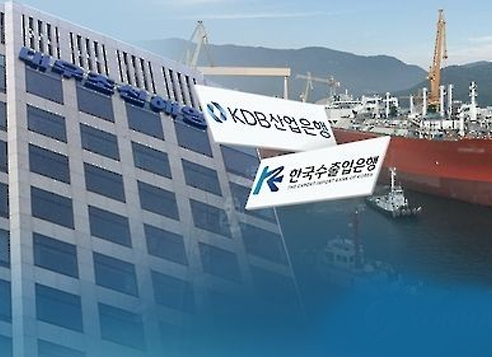Daewoo Shipbuilding and Marine Engineering, a South Korean ailing shipbuilder, is facing looming uncertainties over the company’s future, with bondholders raising skeptical voices over a fresh rescue plan which might have an impact on securing deals, experts said Tuesday.
It is expected that the shipyard, which has the world’s largest backlog orders, will sign two deals by the end of April. DSME is scheduled to sign a $250 million deal this month at the earliest to build three very large crude carriers and finalize a deal to build floating storage and regasification units next month.
 |
The corporate logos of the main creditors of Daewoo Shipbuilding & Marine Engineering Co. are superimposed over a composite of the shipbuilders' headquarters building and one of its shipyards in this undated image provided by Yonhap News TV. (Yonhap) |
But as uncertainty grows over the company’s latest rescue plan, industry watchers point out that this might take a toll on its ability to secure new deals.
“Daewoo Shipping may face difficulties in securing new deals as uncertainties over the company continue and some might take advantage of this situation in negotiating with the shipyard,” an industry source said.
The main creditors of DSME, led by Korea Development Bank, announced a new financial aid plan last week. According to the plan, KDB and The Export-Import Bank of Korea will inject fresh liquidity worth 2.9 trillion won ($2.6 billion), but only if debtholders agree to swap 2.9 trillion won of debt into equity and give a three-year grace period on repayment of the remaining debt.
While KDB and Eximbank will swap 100 percent of the debt worth 1.6 trillion won with shares in the company, other creditors including the National Pension Service, are still mulling their options and some experts have cried foul over the rescue plans.
Lim Jung-min, a credit analyst at NH Investment & Securities said unfairness in burden sharing and an uncertain industrial outlook make it difficult for creditors to decide whether to back the new rescue package.
“While loss for the corporate bonds of shipbuilding companies increased due to investors’ improper investment decisions, the liquidity crisis of DSME has stemmed from the moral hazard of the main creditor banks and it should be clearly distinguished in terms of responsibilities,” Lim said.
“Even if the debt structuring plan goes through, it is not certain that the company will be able to repay the principal three years later considering the company will be downsized in accordance with the new plan,” Lim added.
On Monday, KDB met five commercial lenders that hold unsecure loans to the shipbuilder. During the meetings, the banks were asked to swap 80 percent of their combined 721 billion won of unsecured loans with shares in DSME and give a grace period of five years for the rest of the loans. The banks include KB Kookmin Bank, KEB Hana Bank, NH Bank, Shinhan Bank and Woori Bank. They have tentatively agreed on the new rescue plan on the condition that other creditors take part in the financial aid. The commercial banks will submit their documented final decision by the end of this week, an official at KDB said.
“Negotiation with the commercial banks is going smoothly but the most difficult part is whether or not other institutional investors such as National Pension Service will agree with the plan,” an official at the financial regulator said.
The shipyard is set to meet the National Pension Service, which holds about 30 percent of DSME’s corporate bonds, in the hope of persuading the fund to come on board.
Bondholders of Daewoo Shipbuilding will have meetings on April 17 and 18.
If the creditors fail to agree on the debt-for-equity swap plan, the ailing shipbuilder will be placed under a prepackaged plan that combines debt workout and court receivership.
By Park Ga-young (
gypark@heraldcorp.com)








![[Today’s K-pop] Blackpink’s Jennie, Lisa invited to Coachella as solo acts](http://res.heraldm.com/phpwas/restmb_idxmake.php?idx=644&simg=/content/image/2024/11/21/20241121050099_0.jpg)